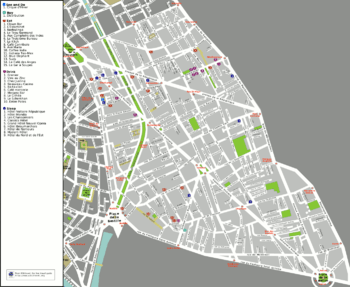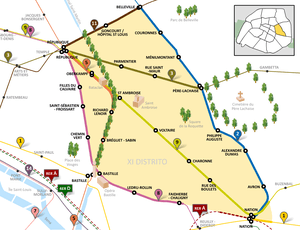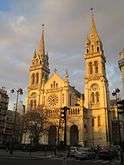11th arrondissement of Paris
The 11th arrondissement of Paris (XIe arrondissement) is one of the 20 arrondissements of the capital city of France. In spoken French, this arrondissement is referred to as onzième.
11th arrondissement of Paris XIe arrondissement | |
|---|---|
 The Cirque d'Hiver | |
 Paris and its closest suburbs | |
| Country | France |
| Region | Île-de-France |
| Department | Paris |
| Commune | Paris |
| Government | |
| • Mayor | François Vauglin (PS) |
| Area | |
| • Total | 3.67 km2 (1.42 sq mi) |
| Population (2017-01-01)[1] | |
| • Total | 146,643 |
| • Estimate (2005) | 152,500 |
| • Density | 40,000/km2 (100,000/sq mi) |
| 1 Population sans doubles comptes: single count of residents of multiple communes (e.g. students and military personnel). | |
 Paris Coat of Arms 20 arrondissements of Paris | |||||||||||||||||||||||||||||||||||||
|---|---|---|---|---|---|---|---|---|---|---|---|---|---|---|---|---|---|---|---|---|---|---|---|---|---|---|---|---|---|---|---|---|---|---|---|---|---|
| |||||||||||||||||||||||||||||||||||||
The arrondissement, called Popincourt, is situated on the right bank of the River Seine. The arrondissement is one of the most densely populated urban districts of any European city.
Description
The eleventh arrondissement is a varied and engaging area. To the west lies the Place de la République, which is linked to the Place de la Bastille, in the east, by the sweeping, tree-lined Boulevard Richard-Lenoir, with its large markets and children's parks. The Place de la Bastille and the rue du Faubourg St Antoine are full of fashionable cafés, restaurants, and nightlife, and they also contain a range of boutiques and galleries. The Oberkampf district to the north is another popular area for nightlife. The east is more residential, with more wholesale commerce, while the areas around the Boulevard Voltaire and the Avenue Parmentier are livelier crossroads for the local community. In recent years this district has emerged as one of the trendiest regions of Paris.
On November 13, 2015, it was the site of coordinated shootings and bombings that left 132 dead.
Geography
The land area of this arrondissement is 3.666 km2 (1.415 sq. miles, or 906 acres).
Demography
The peak population of Paris's 11th arrondissement occurred in 1911, with 242,295 inhabitants. Today, the arrondissement remains the most densely populated in Paris, accompanied by a large volume of business activity: 149,102 inhabitants and 71,962 jobs in the last census, in 1999.
The population consists of a large number of single adults, though its eastern portions are more family-oriented. There is a strong community spirit in most areas of the eleventh, and it is interspersed with pleasant squares and parks.
Historical population
| Year (of French censuses) |
Population | Density (inh. per km²) |
|---|---|---|
| 1872 | 167,393 | 45,611 |
| 1911 (peak of population) | 242,295 | 66,092 |
| 1954 | 200,440 | 54,616 |
| 1962 | 193,349 | 52,741 |
| 1968 | 179,727 | 49,025 |
| 1975 | 159,317 | 43,458 |
| 1982 | 146,931 | 40,079 |
| 1990 | 154,165 | 42,053 |
| 1999 | 149,102 | 40,672 |
| 2009 | 152,744 | 41,620 |
Immigration
| Born in Metropolitan France | Born outside Metropolitan France | |||
|---|---|---|---|---|
| 74.5% | 25.5% | |||
| Born in Overseas France |
Born in foreign countries with French citizenship at birth1 | EU-15 immigrants2 | Non-EU-15 immigrants | |
| 1.3% | 4.1% | 4.4% | 15.7% | |
| 1 This group is made up largely of former French settlers, such as pieds-noirs in Northwest Africa, followed by former colonial citizens who had French citizenship at birth (such as was often the case for the native elite in French colonies), and to a lesser extent foreign-born children of French expatriates. Note that a foreign country is understood as a country not part of France in 1999, so a person born for example in 1950 in Algeria, when Algeria was an integral part of France, is nonetheless listed as a person born in a foreign country in French statistics. 2 An immigrant is a person born in a foreign country not having French citizenship at birth. Note that an immigrant may have acquired French citizenship since moving to France, but is still considered an immigrant in French statistics. On the other hand, persons born in France with foreign citizenship (the children of immigrants) are not listed as immigrants. | ||||
Map

Places of interest



 Arrondissement hall
Arrondissement hall Bastille
Bastille
Main streets and squares
Streets
|
|
|
|
Squares
|
|
|
External links
| Wikimedia Commons has media related to 11th arrondissement of Paris. |

- Mairie du 11e website (in French)
- "Populations légales 2017". INSEE. Retrieved 6 January 2020.